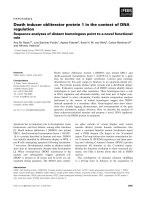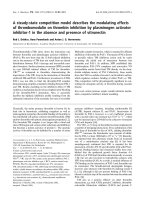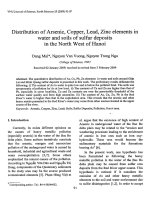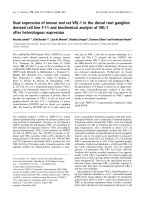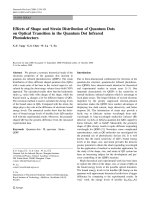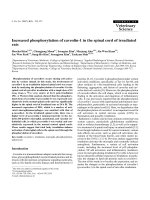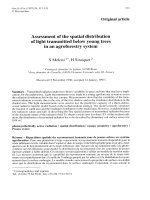Distribution of betaine gaba transporter BGT 1 in excitotoxic brain injury and its role in osmoregulation in the brain
Bạn đang xem bản rút gọn của tài liệu. Xem và tải ngay bản đầy đủ của tài liệu tại đây (7.82 MB, 196 trang )
DISTRIBUTION OF BETAINE/GABA TRANSPORTER BGT-1 IN
EXCITOTOXIC BRAIN INJURY AND ITS ROLE IN OSMOREGULATON
IN THE BRAIN
ZHU XIAOMING
(Bachelor of Medicine, Master of Science)
A THESIS SUBMITTED FOR THE DEGREE OF
DOCTOR OF PHILOSOPHY
DEPARTMENT OF ANATOMY
NATIONAL UNIVERSITY OF SINGAPORE
2005
ACKNOWLEDGEMENTS
First of all, I would like to express my deepest appreciation to my supervisor,
Associate Professor Ong Wei Yi, Department of Anatomy, National University of
Singapore, for his innovative ideas and invaluable guidance throughout this study.
Not only does he train me in the field of neuroscience, but also set a role model as a
hardworking and committed researcher.
I have to thank Professor Ling Eng Ang, Head of Anatomy Department,
National University of Singapore, for his kind assistance in the matriculation and
full support during my studies here.
I am very grateful to Associate Professor Go Mei Lin, Department of
Pharmacy, National University of Singapore, for her generous financial support to
execute some parts of this research. I am also greatly indebted to Dr. Li Guodong,
National University Medical Institutes, National University of Singapore, for his
kind assistance during my work in his laboratory.
I sincerely thank Dr. Lim Sai Kiang, Genome Institute of Singapore, for her
technical guidance and kind support during that period of time when I indulged in
the molecular work in her laboratory. Also thank Miss Joan and Mr. Que Jianwen
in Dr. Lim’s laboratory for their kind help.
I must acknowledge my gratitude to Miss Chan Yee Gek for her teaching in
Electron Microscopy, Mrs. Ng Geok Lan and Mrs. Yong Eng Siang for their kind
assistance, and Mdm Ang Lye Gek Carolyne and Miss Teo Li Ching Violet for
their secretarial assistance. I would like to thank all other staff members and my
1
fellow postgraduate students at Department of Anatomy, National University of
Singapore for their help and support.
A major credit also goes to my dearest parents, my dearest wife, Xu Xinxia and
my dearest daughter, Zhu Lingyi, without their support this work would not have
been completed.
Last, but not least, thanks to the National University of Singapore for supporting
me with a Research Scholarship to bring this study to reality.
2
PUBLICATIONS
Various portions of the present thesis have been published, or have been submitted
for publication.
International Refereed Journals:
Zhu XM, Ong WY (2004) A light and electron microscopic study of betaine/GABA
transporter distribution in the monkey cerebral neocortex and hippocampus. J
Neurocytol 33: 233-240.
Zhu XM, Ong WY (2004) Changes in GABA transporters in the rat hippocampus
after kainate-induced neuronal injury: decrease in GAT-1 and GAT-3 but
upregulation of betaine/GABA transporter BGT-1. J Neurosci Res 77: 402-409.
Zhu XM, Ong WY, Li G, Go ML (2005) Differential effects of betaine and sucrose
on betaine / GABA transporter (BGT-1) expression and betaine transport in human
U373 MG astrocytoma cells and rat hippocampal astrocytes. (In revision).
Conference papers:
Zhu XM, Ong WY (2004) Changes in GABA transporters in the rat hippocampus
after kainate induced neuronal injury. 4th IBRO School, Hong Kong.
3
Zhu XM, Ong WY, Li G, Go ML (2004) Differential effects of betaine and sucrose
on betaine / GABA transporter (BGT-1) expression and betaine transport in human
U373 MG astrocytoma cells and rat hippocampal astrocytes. International
Biomedical Science Conference, Kuming, Yunnan, China.
4
TABLE OF CONTENTS
ACKNOWLEDGEMENTS……………………………………………………….2
PUBLICATIONS………………………………………………………………… 4
TABLE OF CONTENTS………………………………………………………….6
ABBREVIATIONS……………………………………………………………… 12
SUMMARY……………………………………………………………………… 14
CHAPTER 1: INTRODUCTION……………………………………………… 18
1. Maintenance of osmolarity in living cells……………………………………….19
1.1. Maintenance of osmolarity in the kidney………………………………… 20
1.2. Maintenance of osmolarity in the central nervous system…………………20
2. Organic osmolytes……………………………………………………………….22
2.1. Betaine…………………………………………………………………… 22
2.2. Taurine…………………………………………………………………… 25
2.3. Myo-inositol……………………………………………………………… 26
3. Osmolyte transporters……………………………………………………………27
3.1. Betaine/GABA transporter BGT-1…………………………………………27
3.1.1. Cloning of BGT-1……………………………………………………27
3.1.2. Molecular structure of BGT-1……………………………………….29
3.1.3. Distribution of BGT-1……………………………………………….30
5
3.1.4. Functional characterization of BGT-1……………………………….31
3.1.5. Transcriptional regulation of BGT-1 upon hyperosmolarity……… 32
3.1.5.1. Tonicity-responsive enhancer (TonE)……………………….33
3.1.5.2. Transcription factor TonEBP……………………………… 34
3.1.5.3. Osmotic signaling pathway………………………………….35
3.2. Taurine transporter (TauT)…………………………………………………36
3.3. Myo-inositol transporter……………………………………………………37
4. The GABAergic system in the central nervous system…………………………39
4.1. Metabolism of GABA………………………………………………………39
4.2. Function of released GABA……………………………………………… 41
4.3. Plasma membrane GABA transporters…………………………………… 43
4.3.1. GAT-1……………………………………………………………… 44
4.3.2. GAT-2……………………………………………………………… 47
4.3.3. GAT-3……………………………………………………………… 47
5. Excitotoxic brain injury .……………………………………………………… 49
5.1. Experimental models of excitotoxcity - Kainate injections……………… 49
5.2. Osmotic stress in excitotoxcity…………………………………………….50
6. Aims of experimental studies……………………………………………………52
6.1. Study of distribution and subcellular localization of betaine/GABA
transporter BGT-1 in the monkey cerebral neocortex and hippocampus………….53
6.2. Study of changes in the expression of GABA transporters in the rat
hippocampus after kainate induced neuronal injury ………………………………54
6
6.3. Study of differential effects of betaine and sucrose on BGT-1 expression and
betaine transport in human U373MG astrocytoma cells and rat hippocampal
astrocytes……………………………………………………………………………54
CHAPTER 2: MATERIALS AND METHODS………………………………56
1. Animals………………………………………………………………………… 57
2. Intracerebroventricular drug injection………………………………………… 57
2.1. Kainate injections………………………………………………………… 57
2.2. Kainate and betaine injections…………………………………………… 58
3. Western immunoblot analysis………………………………………………… 59
3.1. Solutions……………………………………………………………………59
3.2. Protein extraction………………………………………………………… 62
3.3. Measurement of protein concentration…………………………………….62
3.4. Separation of proteins by running SDS-PAGE gel……………………… 63
3.5. Transferring protein from SDS-PAGE gel to PVDF membrane………… 63
3.6. Detection of protein using antibody……………………………………….64
4. Histology……………………………………………………………………… 65
4.1. Perfusion………………………………………………………………… 65
4.2. Tissue preparations……………………………………………………… 66
4.3. Histochemistry…………………………………………………………… 67
4.3.1. Nissl staining with cresyl fast violet (CFV)…………………………67
4.3.2. Methyl green staining……………………………………………….68
5. Immunohistochemistry………………………………………………………….69
7
5.1. Immunoperoxidase staining……………………………………………… 69
5.2. Cell counts…………………………………………………………………71
5.3. Immunogold staining………………………………………………………71
5.4. Double immunofluorescence labelling…………………………………….73
6. Electron microscopy…………………………………………………………….73
7. Cell culture of human U373 MG astrocytoma………………………………… 75
8. Reverse transcription polymerase chain reaction (RT-PCR)……………………76
9. Cell – ELISA…………………………………………………………………… 78
10. Cell immunofluorescence confocal microscopy……………………………… 79
11. [
14
C] betaine uptake assay………………………………………………………80
12. Statistical analysis………………………………………………………………81
CHAPTER 3: RESULTS…………………………………………………………82
1. Distribution and subcellular localization of betaine/GABA transporter in the
monkey cerebral neocortex and hippocampus…………………………………… 83
1.1. Specificity of antibody…………………………………………………… 83
1.2. Light microscopy………………………………………………………… 83
1.2.1. Cerebral neocortex .………………………………………………….83
1.2.2. Hippocampus……………………………………………………… 84
1.3. Electron microscopy……………………………………………………… 84
2. Changes in the expression of GABA transporters in the rat hippocampus after
kainate induced neuronal injury ………………………………………………… 85
2.1. Western blot analysis……………………………………………………….85
8
2.2. Light microscopy………………………………………………………….85
2.2.1. CA fields of normal or saline-injected rats…………………………85
2.2.2. Three days after kainate injections…………………………………86
2.2.3. One week after kainate injections………………………………… 86
2.2.4. Three weeks after kainate injections………………………… ……87
2.3. Electron microscopy………………………………………… …….…….87
2.4. Double immunofluorescence labelling for BGT-1 and GFAP……………88
3. Differential effects of betaine and sucrose on BGT-1 expression and betaine
transport in human U373MG astrocytoma cells and rat hippocampal astrocytes….88
3.1. Reverse transcription polymerase chain reaction (RT-PCR)………………88
3.2. Cell – ELISA……………………………………………………………….89
3.3. Immunofluorescence confocal microscopy……………………………… 89
3.4. [
14
C] betaine uptake assay………………………………………………….89
3.5. Light microscopy revealed by immunoperoxidase labelling for BGT-1… 90
3.6. Double immunofluorescence labelling for BGT-1 and GFAP…………….90
3.7. Electron microscopy……………………………………………………….91
CHAPTER 4: DISCUSSION…………………………………………………….92
1. Distribution and subcellular localization of betaine/GABA transporter BGT-1 in
the cerebral neocortex and hippocampus………………………………………… 93
1.1. Distribution of BGT-1 in cerebral neocortex and hippocampus………… 93
1.2. Subcellular localization of BGT-1 revealed by electron microscopy………94
9
1.3. Functional implication of BGT-1 in osmoregulation in the central nervous
system…………………………………………………………………………… 94
2. Changes in the expression of GABA transporters in the rat hippocampus after
kainate induced neuronal injury………………………………………………… 95
2.1. Decrease in the expression of GAT-1 after kainate induced neuronal
injury …………………………………………………………………………… 95
2.2. Decrease in the expression of GAT-3 after kainate induced neuronal
injury …………………………………………………………………….……… 96
2.3. Upregulation of BGT-1 in astrocytes after kainate induced neuronal
injury……………………………………………………………………………….96
2.4. Role of BGT-1 in astrocytes in osmoregulation after kainate induced
neuronal injury ……………………………………………………………………97
3. Differential effects of betaine and sucrose on BGT-1 expression and betaine
transport in human U373MG astrocytoma cells and rat hippocampal astrocytes…99
3.1. Effects of betaine or sucrose on BGT-1 expression in vitro 99
3.2. Effects of betaine or sucrose on [
14
C] betaine uptake in vitro 99
3.3. Effects of betaine on BGT-1 expression in vivo………………….……….100
CHAPTER 5: CONCLUSION………………………………………………… 103
CHAPTER 6: REFERENCES……………………………………………… …108
TABLES, TABLE FOOTNOTES, FIGURES AND FIGURE LEGENDS… 154
10
ABBREVIATIONS
BBB blood - brain barrier
BGT-1 betaine/GABA transporter
BSA bovine serum albumin
CA cornu amonis
CA1 hippocampus CA1 area
CA3 hippocampus CA3 area
CAT chloramphenicol acetyltransferase
CNS central nervous system
CPM count per minute
DAB 3, 3 - diaminobenzidine tetrahydrochloride
DNA deoxyribonucleic acid
EDTA ethylenediaminetetraacetic acid
ELISA enzyme linked immunosorbent assay
EMSA electrophoretic mobility shift assay
GABA γ-aminobutyric acid
GABA - T GABA transaminase
GAD glutamic acid decarboxylase
GAT GABA transport
GFAP glial fibrillary acidic protein
GS glutamine synthetase
[
3
H]GABA tritium labelled GABA
11
IC
50
concentration at 50% inhibition
KA kainic acid
K
m
Michaelis constant
MDCK Madin-Darby canine kidney
MW molecular weight
NMR nuclear magnetic resonance
OsO
4
osmium tetroxide
PB phosphate buffer
PBS phosphate-buffered saline
PCR polymerase chain reaction
PKA protein kinase A
PKC protein kinase C
RNA ribonucleic acid
RT - PCR reverse transcription polymerase chain reaction
TauT taurine transporter
TCA tricarboxylic acid
TonE tonicity-responsive enhancer
Tris trihydroxymethylaminomethane
12
SUMMARY
Osmoregulation is critical for maintaining brain function. In response to
hyperosmotic stress, brain cells, including neurons and glial cells can accumulate
organic osmolyte: betaine, myo-inositol and taurine via the osmolyte transport. The
betaine/GABA transporter BGT-1 has been extensively studied in MDCK cells, and
it is responsible for the uptake of betaine into kidney cells when adapted to
hyperosmotic environment. However, the localization and function of BGT-1 in the
brain has been unclear. Although BGT-1 mRNA is widely expressed in the brain,
previous studies on distribution of BGT-1 in the brain are only carried out at mRNA
level using Northern blot and in-situ hybridization. The distribution and subcellular
location of BGT-1 has to be addressed at protein level, in order to gain a thorough
understanding of its function in the brain. BGT-1 is capable of transporting both
betaine and GABA, as examined in Xenopus oocytes and various cell lines. But the
physiological substrate of BGT-1 in the brain remains to be determined. Of
particular interest is the elucidation of the role of BGT-1 in excitotoxic brain injury,
since under such circumstances of neuronal injury, osmotic stress resulted to certain
extent from the release of neuronal content, including the highly abundant betaine,
as well as the altered levels of extracellular GABA, could be related to the function
of BGT-1.
The present study first addressed the question of what is the normal distribution
and subcellular location of BGT-1 in the brain. The use of a specific antibody to
BGT-1 detected the presence of BGT-1 in the cell bodies and dendrites of pyramidal
13
neurons in the cerebral neocortex and CA fields of hippocampus. Electron
microscopy reveals that BGT-1 is postsynaptically localized in asymmetric synapse.
The distribution of BGT-1 on dendritic spines, rather than at GABAergic axon
terminals, suggests that the transporter is unlikely to play a major role in terminating
the action of GABA at a synapse. Instead, the osmolyte betaine is more likely to be
the physiological substrate of BGT-1 in the brain, and the presence of BGT-1 in
pyramidal neurons suggests that these neurons utilize betaine to maintain osmolarity.
Meanwhile, the present study explored the changes in the expression of GABA
transporters in the rat hippocampus after kainate-induced neuronal injury, since
changes in expression of GABA transporters/BGT-1 might result in alterations in
levels of GABA/betaine in the extracellular space, with consequent effects on
neuronal excitability or osmolarity. A decrease in GAT-1 and GAT-3
immunostaining, but no change in GAT-2 staining, was observed in the degenerating
CA subfields. In contrast, increased BGT-1 immunoreactivity was observed in
astrocytes after kainate injection. BGT-1 is a weak transporter of GABA as
compared to other GABA transporters, and the increased expression of BGT-1 in
astrocytes might be a protective mechanism against increased osmotic stress known
to occur after excitotoxic injury. On the other hand, excessive or prolonged BGT-1
expression might be a factor contributing to astrocytic swelling after brain injury.
It is conceivable that BGT-1 could have been induced in astrocytes as a result of
induction by betaine or hyperosmotic stress after excitotoxic injury. Finally, the
present study investigated the possible changes in betaine transporter expression and
its function in astrocytes, after treatment with high concentrations of betaine or
14
sucrose in vitro, as well as the effect of betaine on its transporter BGT-1 in reactive
astrocytes in vivo. Treatment of human U373 MG astrocytoma cells for 12 hours
with 1-100 mM of betaine, but not equivalent concentrations of sucrose, resulted in
increased BGT-1 immunointensity by ELISA. The increased BGT-1 was present in
the cytoplasm and cell membrane. Treatment of cells with 1-100 mM betaine also
resulted in increased [
14
C] betaine transport into the cells, consistent with increased
BGT-1 transporter function. No increase in betaine uptake was observed when cells
were treated with 1 and 10 mM sucrose, but a large increase was observed when
cells were treated with 100 mM sucrose. In contrast to rats received
intracerebroventricular injection with kainate plus saline, which showed loss of
BGT-1 immunoreactivity in neurons and little induction of BGT-1 in astrocytes, a
marked increase in BGT-1 immunoreactivity was observed in astrocytes in the
degenerating CA fields and fimbria, in rats injected with kainate plus betaine. These
astrocytes were found to have swollen mitochondria at electron microscopy. In view
of the above findings, it is postulated that the release of betaine from dying neurons
could be a factor contributing to increase BGT-1 expression in astrocytes. This
might contribute to astrocytic swelling following head injury or stroke.
In summary, the present study has revealed the distribution of betaine/GABA
transporter BGT-1 in normal brain and in excitotoxic brain injury, as well as the
expression and functional changes of BGT-1 in astrocytes in response to
hyperosmolarity in vitro and in vivo. Overall, the present study has dissected the role
of BGT-1 in osmoregulation in the brain. Further studies are necessary to study the
15
mechanism by which betaine induces BGT-1 expression and the effects of BGT-1
inhibitors on astrocytic swelling.
16
CHAPTER 1
INTRODUCTION
17
1. Maintenance of osmolarity in living cells
Maintenance of osmotic balance is an important aspect of cellular homeostasis.
When exposed to extracellular hyperosmolarity, cells initially lose water and shrink,
thus concentrating intracellular inorganic ions. Accumulation of inorganic ions (e.g.,
sodium and potassium salts) and crowding of large intracellular molecules have been
demonstrated to compromise the function of proteins, DNA and other cellular
macromolecules (Yancey et al., 1982; Minton, 1983; Garner and Burg, 1994). Upon
the prolonged hyperosmotic challenge, virtually all cells from bacterial to
mammalian slowly accumulate certain small organic solutes, e.g., betaine, taurine
and myo-inositol, to achieve osmotic balance. Compared to the high concentrations
of intracellular inorganic ions, these small organic solutes generally do not perturb
the function of macromolecules, so termed compatible (or non-purturbing)
osmolytes (Yancey et al., 1982). Accumulation of specific osmolytes results from
their intracellular synthesis or uptake from extracellular space via the corresponding
osmolyte transporters (Burg, 1995). On the other hand, adaptation of cells to
hypoosmotic condition requires the release of intracellular osmolytes (Kwon and
Handler, 1995).
Since cell membrane is highly permeable to water, disturbance in
osmoregulation would directly affect the cell volume, thus interfering with a
multitude of cell functions (Lang et al., 1998).
18
1.1. Maintenance of osmolarity in the kidney
Maintenance of osmolarity is essential for the physiological functioning of
kidney cells. The renal medulla is the site of final urine formation. The
hyperosmolarity in renal medulla provides the driving force for extraction of water
from the urine, thus concentrating urine. Osmolarity of the renal medulla can be
easily raised to over 1000 mosM in humans and over 3000 mosM in rats (Garcia-
Perez and Burg, 1991; Sone et al., 1995). To balance the high extracellular
osmolarity, cells in the inner renal medulla accumulate large amounts of certain
osmolytes, predominantly sorbitol, myo-inositol, betaine and taurine (Burg et al.,
1997). These organic osmolytes help to protect the cells against hyperosmolarity.
Therefore, physiological functioning of the kidney depends critically on the ability
of the renal medullary cells to adapt to the hyperosmolarity.
1.2. Maintenance of osmolarity in the central nervous system
Osmoregulation plays a critical role in the brain, where changes in cell volume
can not be tolerated due to the rigid, non-expandable skull and where alterations in
ion composition would affect excitability (Strange, 1992; Gullans and Verbalis,
1993; Law, 1994a; Lang et al., 1998).
Hypernatremia and hyponatremia are very common clinical problems.
Hyperosmolarity as a result of hypernatremic state leads to the cellular dehydration
due to water movement from the intracellular space to the hyperosmotic
extracellular space. In response to hyperosmolarity, brain cells subsequently
accumulate osmolytes to restore to the normal volume level. Exposure of cultured
19
brain cells to hyperosmolarity shows a significant increase in the content of organic
osmolyte (Strange et al., 1991; Beetsch and Olson, 1996). Studies of hypernatremic
animals indicate that the organic osmolyte accumulation generally accounts for 30-
50% of the total osmolyte accumulation (Chan and Fishman, 1979; Heilig et al.,
1989; Lien et al., 1990). When hypernatremic state persists and exceeds the brain’s
ability to compensate for cellular dehydration, such neurological symptoms as
irritability, stupor, hyperreflexia and coma would develop (Arieff, 1984; Gullans and
Verbalis, 1993).
It is well documented that hyponatremia causes brain edema as a consequence
of influx of water into brain. Due to increased intracranial pressure, brain edema
leads to life-threatening cessation of the brain’s blood supply and neuronal death
(Kimelberg, 1995; Pasantes-Morales et al., 2002). To adapt to hypoosmolarity, brain
cells exclude intracellular osmolytes, mainly the inorganic ions potassium (K
+
) and
chloride (Cl
-
) and a number of organic osmolytes. Release of organic osmolytes has
been shown to contribute significantly to the adaptive response to hyponatremia
(Lien et al., 1991; Verbalis and Gullans, 1991; Sterns et al., 1993). In vitro studies in
both neurons and astrocytes also demonstrate the persistent exclusion of organic
osmolytes, e.g., taurine following hypoosmotic stimulus (Pasantes and Schousboe,
1988; Schousboe et al., 1991; Olson, 1999).
In addition, osmotic stress directly influences neuronal electrophysiological
function. Alteration in ion concentrations in extracellular as well as intracellular
spaces would affect membrane potential and the resulting neuronal excitability.
Neuronal excitability increases significantly in hippocampal slices under
20
hypoosmotic conditions (Chebabo et al., 1995). The hypoosmotic-associated
hyperexcitability has been shown in patients of hyponatremia with an increased
susceptibility to seizures (Andrew, 1991). In vitro studies in brain slices reveal that
osmolarity reduction enhances the synaptic transmission whilst raising osmolarity
depresses synapses (Rosen and Andrew, 1990; Chebabo et al., 1995; Huang et al.,
1997). When confronted with hyperosmolarity, neurons of primary culture show
enhanced voltage-dependent Ca
2+
currents and depressed K
+
currents (Somjen,
1999).
2. Organic osmolytes
The different organic osmolytes that are accumulated by cells fall into three
classes: methylamines, such as betaine and glycerophosphorylcholine; polyalcohols,
such as myo-inositol and sorbitol; and amino acids or amino acid derivatives, such
as glycine and taurine (Lang et al., 1998). The followings highlight some major
osmolytes in the brain.
2.1. Betaine
Betaine (N, N, N-trimethylglycine) has been shown an osmoprotective role in
many plant, animal and bacterial species (Yancey et al., 1982; Le Rudulier and
Bouillard, 1983; Perroud and Le Rudulier, 1985; Bagnasco et al., 1986; Yancey and
Burg, 1990). It is well documented that the kidney medulla becomes hyperosmotic
when concentrating urea and large amounts of betaine is intracellularly accumulated
(Bagnasco et al., 1986; Balaban and Burg, 1987; Garcia-Perez and Burg, 1991).
21
In addition to the uptake from the extracellular environment through transporter,
betaine can be synthesized in vivo from its precursor, choline. Production of betaine
by oxidation of choline has been reported in gut mucosa (Flower et al., 1972), liver
(Glenn and Vanko, 1959; Wilken et al., 1970), and kidney (Haubrich et al., 1975).
Fig 1 illustrates the metabolic pathway for betaine synthesis and degradation.
Betaine is synthesized via two oxidative steps. Choline is oxidized by choline
dehydrogenase (EC 1.1.99.1) to betaine aldehyde, which is further oxidized to
betaine by betaine aldehyde dehydrogenase (EC 1.2.1.8) (Rothschild and Barron,
1954). Choline dehydrogenase itself may also be able to catalyze both steps (Tsuge
et al., 1980).
Betaine degradation is catalyzed by betaine homocysteine methyltransferase
(EC 2.1.1.5) (Skiba et al., 1987). In this reaction, a methyl group is transferred from
betaine to homocysteine to form methionine. After donating its methyl group,
betaine becomes dimethylglycine. It has been well-documented that in liver, betaine
acts as a methyl donor in the detoxification of homocysteine (Gaitonde, 1970;
Finkelstein et al., 1982). Clinically, betaine is used for treatment of homocystinuria,
which caused by a genetic defect in cystathione β-synthase (an enzyme in the trans-
sulfuration pathway of homocysteine metabolism) (Smolin et al., 1981; Wilcken and
Wilcken, 1997; Walter et al., 1998).
Within the kidney, the production of betaine from choline occurs in proximal
tubule (Wirthensohn and Guder, 1982; Miller et al., 1996) and renal medullary cells
(Grossman and Hebert, 1989; Lohr and Acara, 1990), both of which contain choline
dehydrogenase activity. It raises the possibility that alterations of betaine synthesis
22
in the renal medulla may contribute to its osmotic regulation. However, no evidence
favors this. Hypernatremia, which results in major accumulation of betaine in renal
medullas, does not show an increase in the activity of choline dehydrogenase
(Grossman and Hebert, 1989). MDCK (Madin-Darby canine kidney) cells, which
accumulate betaine when grown in hyperosmotic media, have little capacity to
synthesize betaine and rely on uptake from the medium (Nakanishi et al., 1990).
Thus, the role of betaine synthesis in osmoregulation is not well supported.
In contrast, betaine metabolism is poorly characterized in the central nervous
system (CNS), although betaine has been detected in rat brain (Heilig et al., 1989;
Lien et al., 1990; Lien, 1995; Koc et al., 2002). No information on betaine synthesis
in CNS has been reported. The activity of betaine homocysteine methyltransferase,
the enzyme responsible for betaine degradation, is absent in brain (McKeever et al.,
1991). It is likely that betaine synthesized elsewhere, e.g. liver, kidney, is
transported into the brain via blood-brain barrier (BBB), since betaine/GABA
transporter BGT-1 is localized in BBB (Takanaga et al., 2001). High concentrations
of betaine (100-300 mM) have been found in single neurons isolated from the
abdominal ganglion from Aplysia Californica using nuclear magnetic resonance
(NMR) spectroscopy. The levels of betaine in brain are increased following salt
loading, suggesting a role of betaine in osmoregulation in the CNS (Lien et al.,
1990). It is noteworthy that cerebral edema was clinically reported in patients treated
with betaine (Yaghmai et al., 2002; Devlin et al., 2004).
23
2.2. Taurine
Taurine (2-aminoethanesulfonic acid) is widely distributed in the brain, and its
intracellular concentration can reach tens of milliMolar (Palkovits et al., 1986;
Huxtable, 1989). The highest levels of taurine are present in cerebral cortex,
hippocampus, caudate-putamen, cerebellum and hypothalamic supraoptic nuclei,
while lower levels are found in the brain stem (Palkovits et al., 1986). Taurine has
been detected in neurons, e.g., cerebellar Purkinje neurons, neurons of cortex and
hippocampus, as well as in glial cells (Hussy et al., 2000). The biosynthesis of
taurine is primarily from cysteine derived in part from methionine via the cysteine
sulfinate pathway, which includes oxidation of cysteine to cysteine sulfinate by
cysteine dioxygenase and decarboxylation of cysteine sulfinate by cysteine sulfinate
decarboxylase (Foos and Wu, 2002; Tappaz, 2004).
The role of taurine in osmoregulation in the brain has been well established.
Efflux of taurine in response to osmotic reduction has been consistently shown in
numerous preparations of in vitro studies, including neurons (Schousboe et al., 1991;
Pasantes-Morales et al., 1994), astrocytes (Pasantes and Schousboe, 1988;
Kimelberg et al., 1990; Vitarella et al., 1994), and brain slices (Oja and Saransaari,
1992; Law, 1994b). In vivo studies on hyponatremia confirm a decreased level of
taurine in brain (Thurston et al., 1987; Verbalis and Gullans, 1991; Lien et al., 1991).
On the other hand, intracellular accumulation of taurine as a result of hyperosmotic
stimulus has been demonstrated in cultured astrocytes (Olson and Goldfinger, 1990;
Sanchez-Olea et al., 1992), as well as in vivo studies (Thurston et al., 1980; Lien et
24
